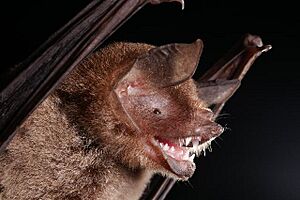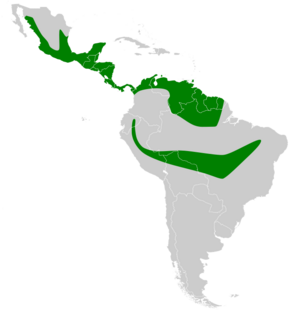Parnell's mustached bat facts for kids
Quick facts for kids Parnell's mustached bat |
|
|---|---|
 |
|
| Conservation status | |
| Scientific classification | |
| Genus: |
Pteronotus
|
| Species: |
parnellii
|
| Subspecies | |
|
P. p. parnellii |
|
 |
|
The Parnell's mustached bat (Pteronotus parnellii) is a type of bat that eats insects. It lives in the Americas, from southern Sonora, Mexico, all the way south to Brazil. Long ago, these bats lived in more places, like the island of New Providence in the Bahamas.
This bat was named after a British animal expert called Richard Parnell.
Contents
About Parnell's Mustached Bat
This bat is quite large for a bat. Its forearm, which is like its wing-arm, is about 6 centimeters (2.4 inches) long. Its ears are short and pointy. Unlike some other bats, it doesn't have a leaf-like shape on its nose. Its lips are wrinkly and shaped like a funnel.
Where They Live and What They Do
Parnell's mustached bats like places that are a bit wet. You can also find them in some dry forests where trees lose their leaves. They are mostly active at night, which means they are nocturnal. During the day, they rest in caves and old mines. They come out shortly after the sun sets and stay active for about five to seven hours.
What They Eat
Parnell's mustached bat is an insectivore, meaning it eats insects. They enjoy a variety of bugs like beetles, moths, flies, and dragonflies. Many bats that eat insects prefer to hunt near rivers because there are lots of water insects there. However, Parnell's mustached bat usually hunts away from rivers. This is because they find more nutritious food in other areas. Hunting in these places takes more energy because there are often more leaves and branches to fly around.
Life Cycle and Reproduction
During the time when they have babies, female bats gather in warm caves. They sometimes share these caves with other bat species, like the Cuban flower bat. The mothers usually give birth around July. They then nurse their pups (baby bats) until about October. The young bats only leave the safety of their birth cave to find food once their forearms are as long as an adult's. Baby bats' calls sound different from adult bats' calls. Their calls usually get higher in pitch as they grow older.
How They Use Sound (Echolocation)
Parnell's mustached bat uses a special skill called echolocation to find its way and hunt. This is like having built-in sonar. They make long, steady sounds called "constant frequency" (CF) calls. These calls also have short, changing sounds called "frequency modulations" (FM).
The bat is very good at adjusting its calls. It makes sure that the echoes it hears back are always around 61 kilohertz (kHz). This is a very specific sound frequency. Their inner ears are specially made to hear sounds around 61 kHz. The long, steady part of their call helps them figure out if something is moving towards or away from them. The short, changing part helps them know how far away an object is. Besides echolocation, these bats also use other ways to communicate with each other. They are the only bats in their family (Mormoopidae) that can use this advanced type of sonar.



